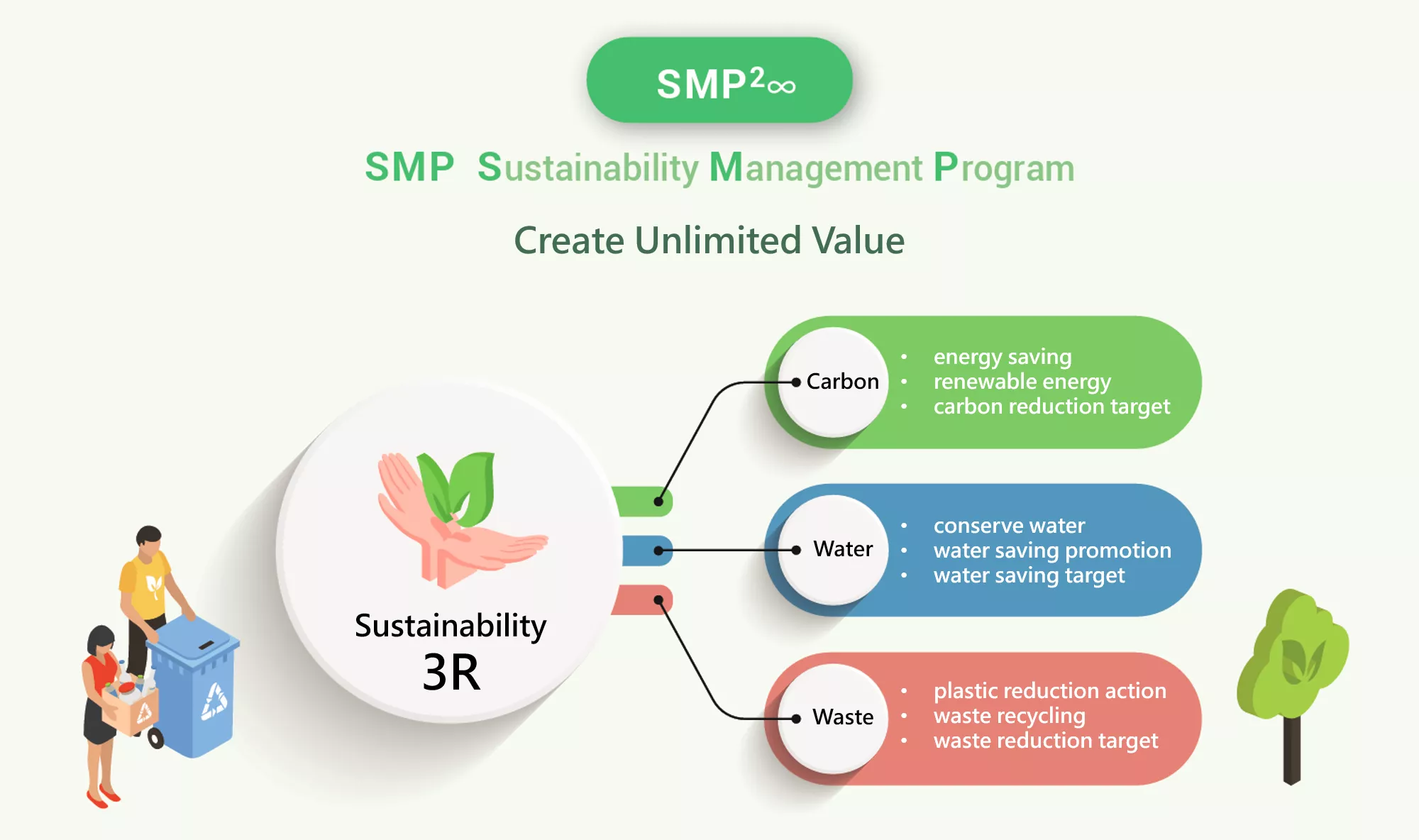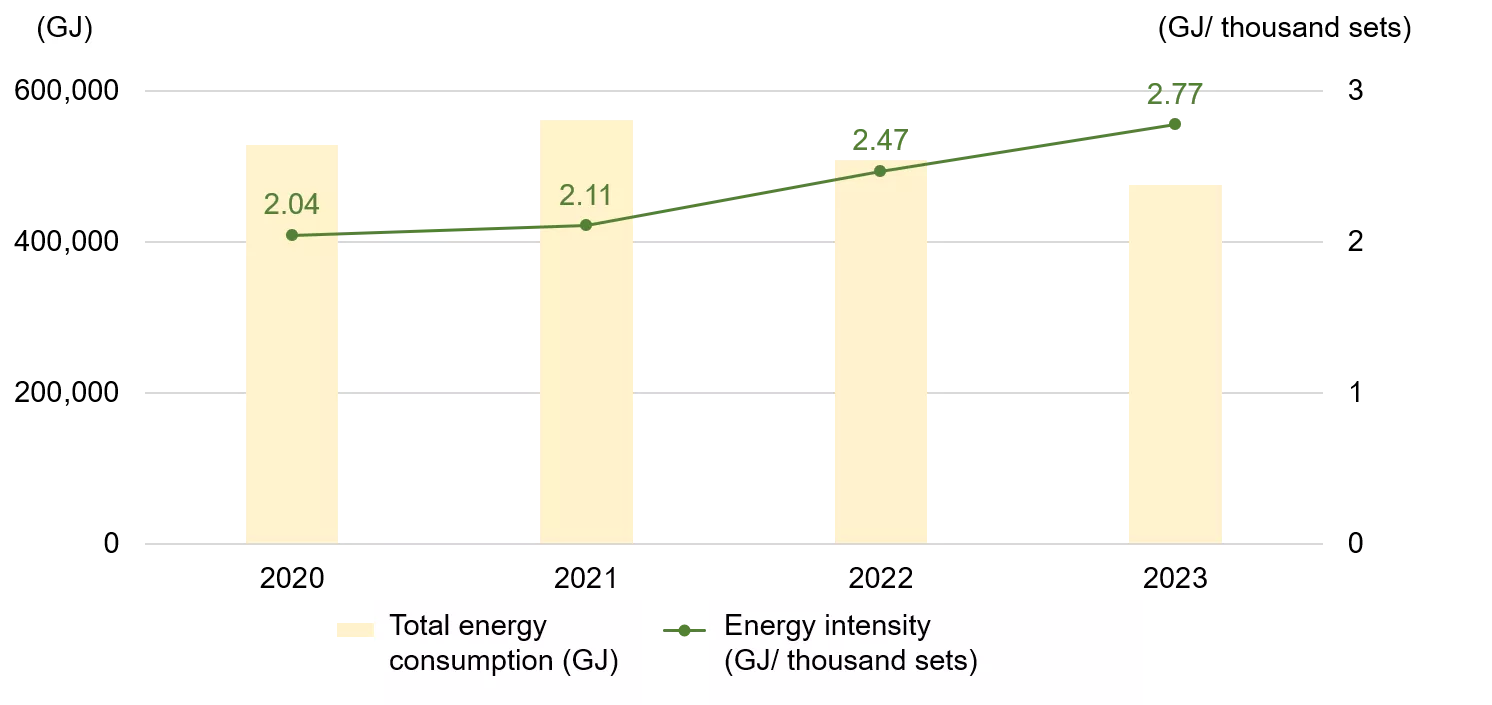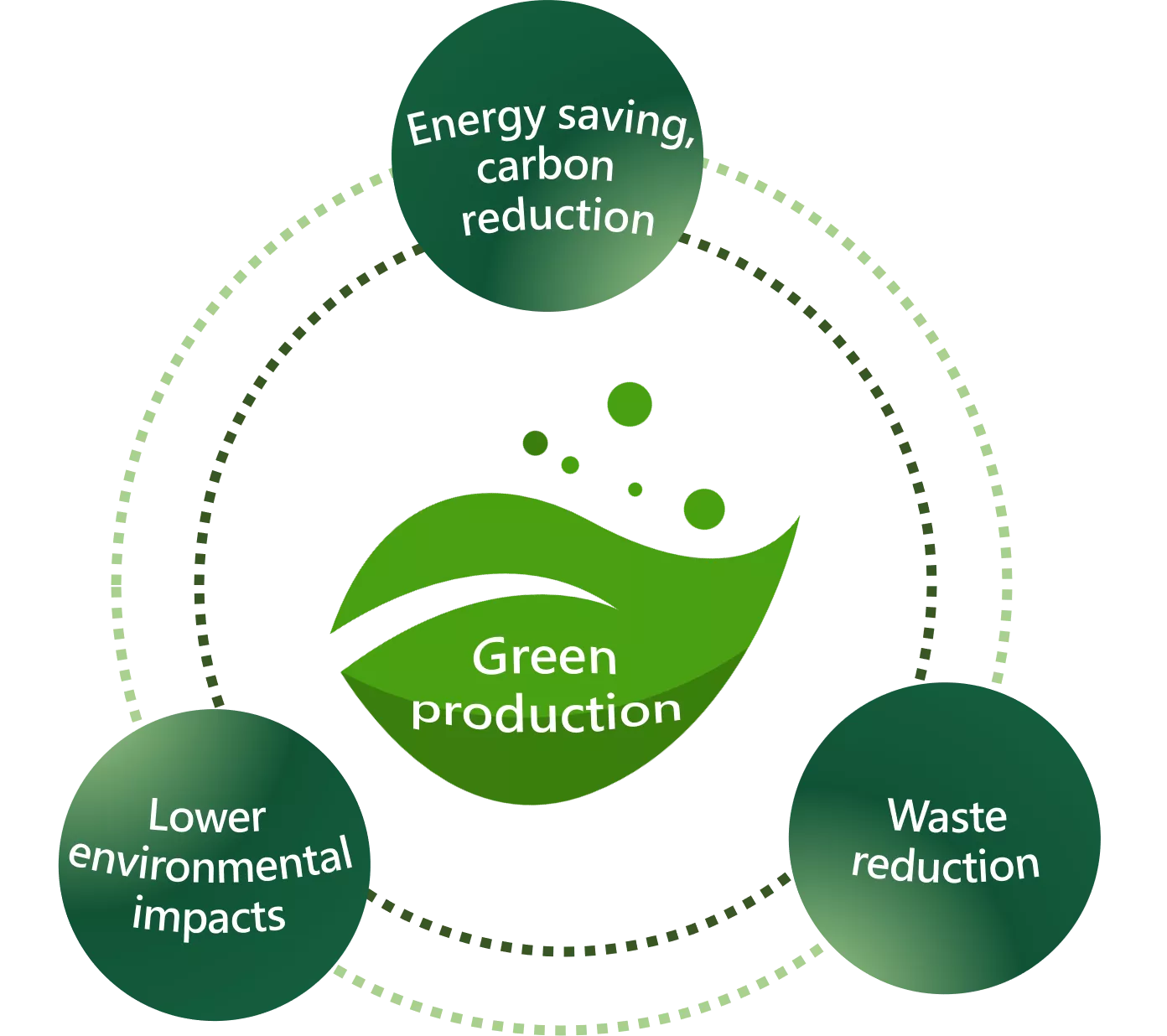|
 |
Energy saving and carbon reduction targets
- Better than statutory requirements, the annual electricity saving rate is greater than the regulatory target of 1%.
- Reduce absolute scope 1 and 2 GHG emissions 51% by 2030 from a 2020 base year.
- Reduce absolute scope 3 GHG emissions from purchased goods and services 25% by 2030 from a 2020 base year.
Waste emission reduction target
- Reduce non-hazardous waste intensity by 10% by 2030 from a 2023 base year.
Water resource management targets
- Reduce water consumption intensity by 20% by 2030 from a 2021 base year.
Energy Management
Simplo Group is a professional lithium-ion battery module manufacturer, and the main energy used is purchased power, followed by the utilization of diesel and gasoline. Total energy consumption in 2023 is decreased, compared to the previous year, while energy intensity increased by 12% compared with 2022. The impact is due to the reduction of production process requirements in line with customer needs, the construction of high-efficiency automated processes, and the addition of unmanned workshops and automated production line equipment.
However, this is affected by the decline in output. impact, causing energy intensity to increase. Simplo Chongqing has introduced the ISO 50001 energy management system in 2022 and obtained third-party verification. In the future, it will continue to monitor and develop energy-saving measures to improve electricity efficiency and achieve energy conservation and carbon reduction.
Energy Efficient
| Year | Diesel fuel (GJ) |
Gasoline (GJ) |
Electricity - non-renewable energy (GJ) |
Electricity - renewable energy (GJ) |
Total energy consumption (GJ) |
Output (thousand sets) |
Energy intensity (GJ/thousand sets) |
|---|---|---|---|---|---|---|---|
| 2021 | 626 | 1,887 | 400,363 | 158,656 | 561,532 | 266,600 | 2.11 |
| 2022 | 444 | 1,343 | 90,966 | 416,206 | 508,960 | 206,250 | 2.47 |
| 2023 | 438 | 1,661 | 167,058 | 306,105 | 475,262 | 171,300 | 2.77 |
1. Electricity conversion factor: 1 kWh=0.0036 GJ.
2. Heat conversion factors: diesel- Taiwan =0.035169 GJ/L, China= 0.042652 GJ/kg; gasoline- Taiwan = 0.032657 GJ/L, China= 0.043070 GJ/kg.
3. Energy intensity formula: energy consumption (GJ)/ thousand sets of battery modules.
4. The disclosure scope of the data in the above table is the parent and subsidiary companies of Simplo Group's consolidated financial statements.
|
 |
Usage of Renewable Energy
Simplo Group is responding to the global transformation to low-carbon energy by installing rooftop solar photovoltaic systems, entering into renewable energy certificates to increase the proportion of renewable energy use. This gradual approach aims to achieve the RE100 target by 2040. In 2023, the Group's use of renewable energy accounted for 65% (note). The usage status of various renewable energy sources are explained below:
-
Installing rooftop solar photovoltaic systems: Since 2022, the main operational sites have installed rooftop solar photovoltaic systems, with a total capacity of 10.8 MW. The cumulative electricity generated amounts to 8,955 Mwh, with a total investment of approximately NTD 250 million.
-
Signing Power Purchase Agreement (PPA): Signing a Power Purchase Agreement (PPA) with an electricity supplier for purchasing renewable energy. Monthly verification of the usage of renewable energy (wind and solar) will be done through the Jiangsu Electricity Trading Platform to obtain Green Electricity Certificates (GECs).
-
Purchasing renewable energy certificates: Purchase locally sourced renewable energy certificates such as International Renewable Energy Certificates (I-RECs).
Note: Renewable energy statistics are based on Simplo Group, including Simplo Taiwan, Simplo Chongqing, Simplo Changshu (including Huapu), Trend Energy, Trend Power, and Trend Power (Changshu), aligned with the RE100 initiative.
Energy Conservation
Simplo is not high energy consuming industry, we committed to enhancing the energy utilization efficiency. For the energy saving, include the lighting, air-compression, chiller and other energy saving apply to effectively lower energy consumption.
Energy saving plans and carbon reduction amount in 2023
| Energy system | Methods | Energy saved (GJ/Year) | GHG emissions (ton CO2e) |
|---|---|---|---|
| Lighting system | 1. Warehouse lighting with infrared light control 2. Replacing office LED tubes with inefficient light decay 3.Reduce the number of lights in non-production areas |
1,387 | 203 |
| Air-compression system | 1. Reduce air compressor outlet pressure by 1kg 2. Constant air pressure operation in the plant 3.Replacing high-energy-consuming air compressors |
7,085 | 1,167 |
| Chiller system | 1. Increase the outlet water temperature of the chiller by 1°C. 2. Installing permanent magnet pumps to replace old fixed-spaced pumps 3.Integrating chillers to reduce the number of units in operation and improve equipment utilization |
2,886 | 465 |
| Total | 11,358 | 1,835 | |
1. The disclosure scope of the data in the above table is the parent and subsidiary companies of Simplo Group's consolidated financial statements.
2. Electricity carbon emission factor:Taiwan: 0.494 kg CO2e/kWh; China: 0.5942 kg CO2e/kWh. Source: Bureau of Energy, Taiwan; Ministry of Ecology and Environment, China.
Water Resource Management
Simplo Group does not use water for manufacturing, but mainly for the domestic use of employees in the factory. Water withdrawals and discharge are following local government regulations, and all waste water is piped and discharged into the sewer system designated by the municipal government for treatment. There is no interaction of shared water resources. The company regularly tracks water consumption, and regularly entrusts testing units to monitor the discharge of water bodies in the factory area, all of which compliance with local discharge standards and have no impact on the local environment.
| Site | Source | Water body | Risk level |
|---|---|---|---|
|
Simplo (Taiwan) |
Dahan River |
Peishih River |
Low - Medium (1-2) |
|
Simplo (Chongqing) |
Yangtze River |
Yangtze River |
Low – Medium (1-2) |
|
Simplo (Changshu) and Huapu |
Yangtze River |
Baimao River |
High (3-4) |
Water Withdrawals
| Year | 2021 | 2022 | 2023 |
|---|---|---|---|
|
Water withdrawal (million liters) |
522.47 |
482.50 |
386.25 |
|
Water discharge (million liters) |
367.57 |
335.90 |
270.44 |
|
Water consumption (million liters) |
154.90 |
146.59 |
115.81 |
|
Water recycling (million liters) |
52.67 |
43.43 |
38.47 |
|
Water recycling rate (%) |
9.16 |
8.26 |
9.06 |
|
Water intensity (million liters/ employees) |
0.055 |
0.076 |
0.068 |
1. The data includs Simplo (Taiwan), Simplo (Chongqing), Simplo (Changshu), and Huapu.
2. Since the first plant of Simplo (Taiwan) has not installed a flow meter for environmental declaration, only the discharge of the second plant is included.
3. Water withdrawal = water discharge + water consumption.
4. Water recycling rate = water recycling / (water withdrawal + water recycling) * 100%.
5. Water intensity = water withdrawal / number of employees at the end of year.
Water Saving Measures
-
The faucets are gradually changed to sensor faucets (Simplo Chongqing)
-
The toilet flushing system was changed to segmented flushing (Simplo Chongqing)
-
Condensed water recycling (Simplo Chongqing)
-
Cooling water tower and process water recycling (Simplo Chongqing)
-
Reduce the water pressure of the faucet to save water
-
Promote colleagues to save water
Water Management (Simplo Chongqing)
- The type of wastewater is domestic wastewater, no production wastewater. The generated domestic sewage enters the biochemical pool for pretreatment. After reaching the third-level discharge standard of the "Integrated Wastewater Discharge Standard", it is connected to the park's municipal sewage pipe network.
- Qualified testing units are regularly entrusted every year to monitor the quality of employees' domestic sewage and rainwater discharge. Monitoring indicators include pH value, suspended solids, chemical oxygen demand, etc.
- In accordance with the requirements of relevant environmental laws and regulations, the rainwater and sewage system in the factory area is diverted, and the discharge status is regularly inspected to avoid overflow.
Waste Management
|
Waste generated during operations process includes hazardous waste and non-hazardous waste, all of which are managed and qualified local contractors for cleanup. Recyclable and household waste are sorted and then handed over to qualified contractors for cleanup and recycling. Waste management focuses on recycling and reuse. Waste that cannot be recycled is incinerated for energy recovery, and finally, any remaining waste will be disposed of in landfills. Note: Simplo Taiwan handles waste through physical processes. Starting from 2033, Simplo Changshu (including Huapu) has changed waste management contractors, with waste incineration now including waste heat recovery. |
 |
Unit: tons
| Year | Category | Incineration (with energy recovery) |
Incineration (without energy recovery) |
Others | Recycle |
|---|---|---|---|---|---|
|
2021 |
Hazardous waste |
38 |
98 |
18 |
198 |
|
General waste |
419 |
1,512 |
- |
4,895 |
|
|
2022 |
Hazardous waste |
44 |
70 |
29 |
219 |
|
General waste |
332 |
1,008 |
1 |
4,468 |
|
|
2023 |
Hazardous waste |
103 |
- |
21 |
200 |
|
General waste |
603 |
- |
- |
6,475 |

